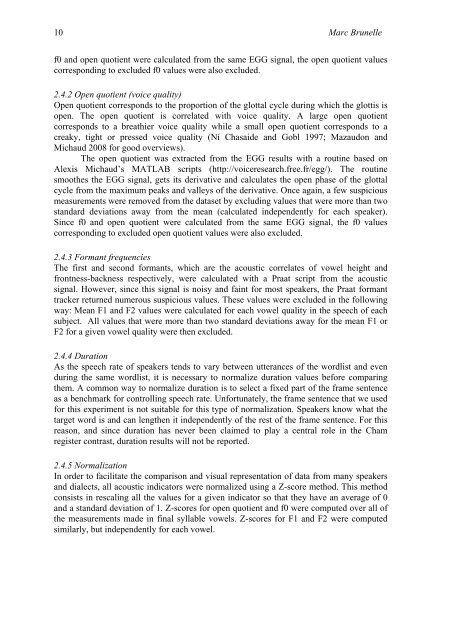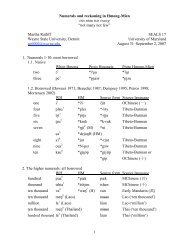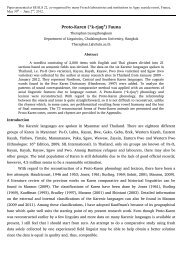proto-southwestern-tai revised: a new reconstruction - seals 22
proto-southwestern-tai revised: a new reconstruction - seals 22
proto-southwestern-tai revised: a new reconstruction - seals 22
Create successful ePaper yourself
Turn your PDF publications into a flip-book with our unique Google optimized e-Paper software.
10 Marc Brunelle<br />
f0 and open quotient were calculated from the same EGG signal, the open quotient values<br />
corresponding to excluded f0 values were also excluded.<br />
2.4.2 Open quotient (voice quality)<br />
Open quotient corresponds to the proportion of the glottal cycle during which the glottis is<br />
open. The open quotient is correlated with voice quality. A large open quotient<br />
corresponds to a breathier voice quality while a small open quotient corresponds to a<br />
creaky, tight or pressed voice quality (Ní Chasaide and Gobl 1997; Mazaudon and<br />
Michaud 2008 for good overviews).<br />
The open quotient was extracted from the EGG results with a routine based on<br />
Alexis Michaud’s MATLAB scripts (http://voiceresearch.free.fr/egg/). The routine<br />
smoothes the EGG signal, gets its derivative and calculates the open phase of the glottal<br />
cycle from the maximum peaks and valleys of the derivative. Once again, a few suspicious<br />
measurements were removed from the dataset by excluding values that were more than two<br />
standard deviations away from the mean (calculated independently for each speaker).<br />
Since f0 and open quotient were calculated from the same EGG signal, the f0 values<br />
corresponding to excluded open quotient values were also excluded.<br />
2.4.3 Formant frequencies<br />
The first and second formants, which are the acoustic correlates of vowel height and<br />
frontness-backness respectively, were calculated with a Praat script from the acoustic<br />
signal. However, since this signal is noisy and faint for most speakers, the Praat formant<br />
tracker returned numerous suspicious values. These values were excluded in the following<br />
way: Mean F1 and F2 values were calculated for each vowel quality in the speech of each<br />
subject. All values that were more than two standard deviations away for the mean F1 or<br />
F2 for a given vowel quality were then excluded.<br />
2.4.4 Duration<br />
As the speech rate of speakers tends to vary between utterances of the wordlist and even<br />
during the same wordlist, it is necessary to normalize duration values before comparing<br />
them. A common way to normalize duration is to select a fixed part of the frame sentence<br />
as a benchmark for controlling speech rate. Unfortunately, the frame sentence that we used<br />
for this experiment is not suitable for this type of normalization. Speakers know what the<br />
target word is and can lengthen it independently of the rest of the frame sentence. For this<br />
reason, and since duration has never been claimed to play a central role in the Cham<br />
register contrast, duration results will not be reported.<br />
2.4.5 Normalization<br />
In order to facilitate the comparison and visual representation of data from many speakers<br />
and dialects, all acoustic indicators were normalized using a Z-score method. This method<br />
consists in rescaling all the values for a given indicator so that they have an average of 0<br />
and a standard deviation of 1. Z-scores for open quotient and f0 were computed over all of<br />
the measurements made in final syllable vowels. Z-scores for F1 and F2 were computed<br />
similarly, but independently for each vowel.





